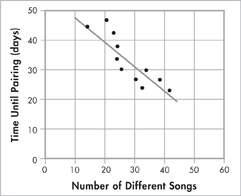Standardized Test Prep
Multiple Choice
A rat that learns to press a button to get food is exhibiting
insight learning.
operant conditioning.
classical conditioning.
habituation.
A dog that always salivates at the ringing of a bell is exhibiting
insight learning.
operant conditioning.
classical conditioning.
habituation.
A chimpanzee that stacks boxes in order to reach a banana hanging from the ceiling is showing
insight learning.
operant conditioning.
classical conditioning.
habituation.
A bird that stops responding to a repeated warning call when the call is not followed by an attack is showing
insight learning.
operant conditioning.
classical conditioning.
habituation.
Which kind of behavior does NOT involve learning?
Habituation
Trial and error
Imprinting
Instinct
A male three-spined stickleback fish will attack male red-bellied sticklebacks and models of fishes that have a red underside. It will not attack males or models lacking a red underside. What can you conclude from the three-spined stickleback's behavior?
The stimulus for an attack is a red underside.
The stimulus for an attack is aggression.
The stimulus for an attack is the presence of a fish with red fins.
The stimulus for an attack is the presence of a fish model.
Which of the following is NOT an innate behavior?
A dog looking for its food dish
A baby mammal sucking milk
A worm moving away from bright light
A spider spinning a web
Questions 8–9
A researcher observed sedge warblers during breeding season. She charted the number of different songs a male bird sang compared to the time it took him to pair with a mate. The graph shows her data.

The researcher was trying to find out whether there is a correlation between
the number of a male bird's songs and the number of offspring.
the number of a male bird's songs and his attractiveness to females.
a male's age and when he mates.
a female's age and when she mates.
What can you conclude based on the graph?
Males prefer females that do not sing.
Females prefer males that do not sing.
Males prefer females with a larger number of songs.
Females prefer males with a larger number of songs.
Open-Ended Response
How does defending a specific territory benefit an animal?
| Question | 1 | 2 | 3 | 4 | 5 | 6 | 7 | 8 | 9 | 10 |
|---|---|---|---|---|---|---|---|---|---|---|
| See Lesson | 29.1 | 29.1 | 29.1 | 29.1 | 29.1 | 29.1 | 29.1 | 29.2 | 29.2 | 29.2 |
Table of Contents
- Formulas and Equations
- Applying Formulas and Equations
- Mean, Median, and Mode
- Estimation
- Using Measurements in Calculations
- Effects of Measurement Errors
- Accuracy
- Precision
- Comparing Accuracy and Precision
- Significant Figures
- Calculating With Significant Figures
- Scientific Notation
- Calculating With Scientific Notation
- Dimensional Analysis
- Applying Dimensional Analysis




